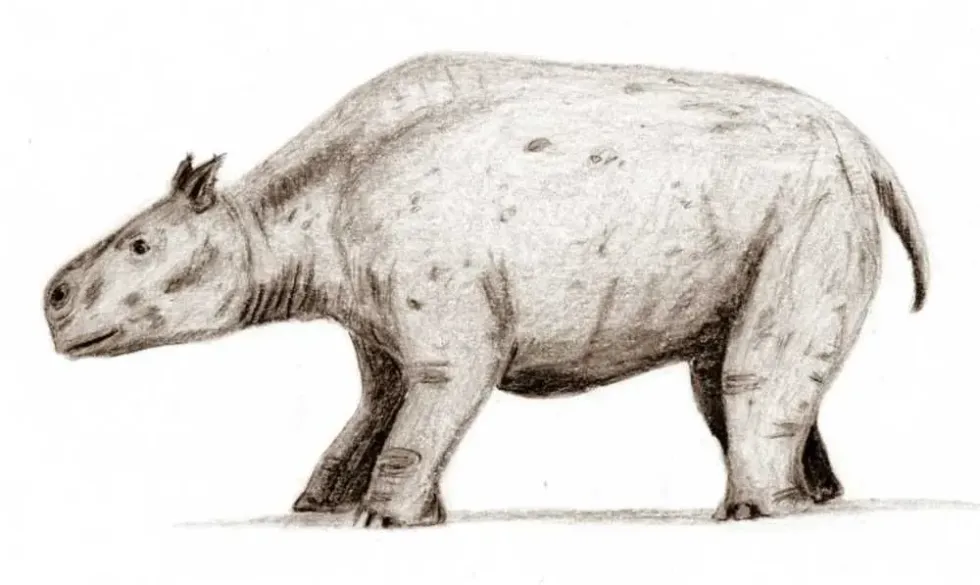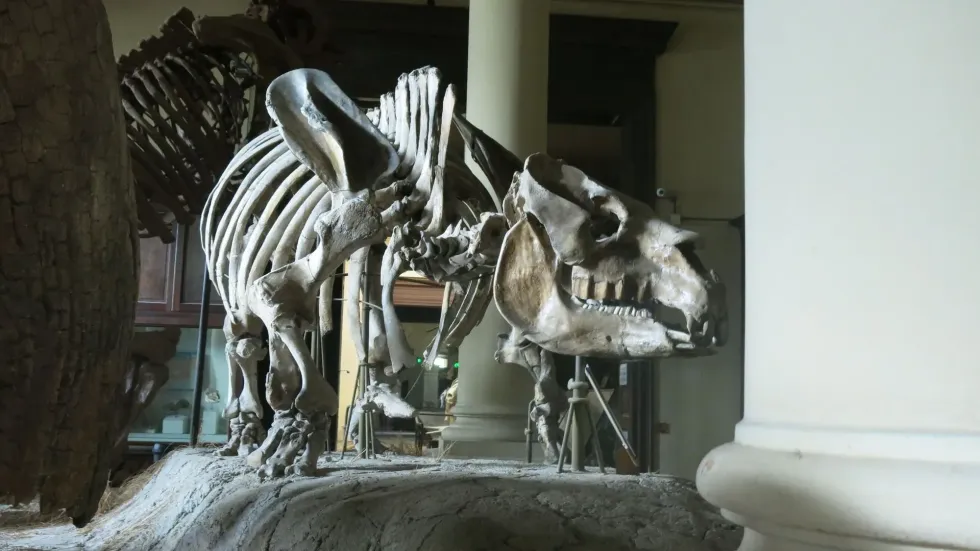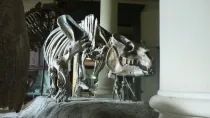Fun Toxodon Facts For Kids

When we talk about the ancestors of hippos or rhinos, the extinct mammal which can be relatable is the Toxodon. Toxodon also called 'bow tooth' is considered as the most common large hoofed mammal in South America from the Late Pliocene period to the Late Pleistocene epochs.
They were herbivorous mammals having a barrel-shaped body like a present-day rhino and also the position of nasal openings like a hippopotamus. They are believed to be a cross between the rhinos and hippos.
The T. platensis was the most common herbivores across South America and lived at the Great American exchange, it is the same place where at present the formation of Isthmus of Panama is created, to join North and South America.
Although they did not have the threat from predator dinosaurs, because they were long extinct, the saber-tooth natural cat species from North America called Smilodon, might have preyed on them. Also as the Toxodon overlapped the time period with humans, a large factor of their extinction might be due to human hunting.
Some of the fossil remains have signs of butchery and arrowheads.
Also, learn amazing and interesting facts by reading about Palaeosaurus and Ornithosuchu.
Toxodon Interesting Facts
Was the Toxodon a dinosaur?
Toxodon is not exactly a dinosaur but it is a type of extinct mammal that lived in a vast range in South America. They faced extinction in the Late Pliocene period, 2.6 million years ago.
How do you pronounce 'Toxodon'?
To pronounce the word 'Toxodon', the phonetic must be 'Tocks-oh-don', breaking the big word into three small phonetic words.
What type of prehistoric animal was a Toxodon?
Toxodon is known as the most common large hoofed mammal in South America from the Late Pleistocene (some of the oldest known specimens in history are about 50,000 years old) and approximately faced extinction in the early Holocene (which began 11,700 years ago).
In which geological period did the Toxodon live?
The Toxodon roamed on the earth during the Late Pliocene (2.6-5.3 million years ago) and Pleistocene epochs (11000-2.6 million years ago).
When did the Toxodon become extinct?
The Toxodon became extinct soon after the last ice age at the beginning of the Holocene period, almost 11,700 years ago. Along with almost all large animals in South America, they are part of the Quaternary extinction event in history. It is also believed that human hunting might be a major reason for their extinction.
Where did a Toxodon live?
The Toxodon platensis was widely distributed in South America during the epochs stage of the Late Pleistocene period, almost 2.6-5.3 million years ago. Their range extended from the Pampas to the Amazon rainforests. They were terrestrial mammals found near the grasslands and river banks.
In the Holocene epochs, they were distributed in Abismo Ponto de Flecha in Brazil. In the Late Pleistocene epochs, they were most common in the grasslands of San Jose, Chaco, and Lujan Formations in Argentina, Tarija, and Nuapua Formations in Bolivia, Brazil, Paraguay, Panama, Sopas, and Dolores Formations, in Uruguay.
Fossil remains of the Miocene-Pliocene period were recovered in Monte Hermoso Formation and Ituzaingo Formation, in Argentina.
What was a Toxodon's habitat?
Earlier it was believed that Toxodon had a semi-aquatic habitat because they had similar looks as hippopotamus, but later reports stated that they had primarily terrestrial life, living in grasslands with semi-arid vegetation and shrubs. They are herbivores and mostly plant-feeders.
Who did a Toxodon live with?
Toxodons mostly lived in herds or small group with their co-species like Adinotherium Trigodon, Mixotoxodon larenis, Thomasshuxleya, Nesodon and they also overlapped time period with the early human species.
How long did a Toxodon live?
There is no record of the lifespan of a Toxodon. The species went extinct 11,000 years ago.
How did they reproduce?
Although there is no such evidence of their reproduction, as they belonged to the genus Toxodon and were mammals, we can assume that they gave birth to one young calf. After the mating, the female species incubates the embryo within itself and gives birth to a young offspring.
Both parents take care of the offspring until it is mature enough to feed and protect itself.
Toxodon Fun Facts
What did a Toxodon look like?
The T. platensis had a large-sized body and head, almost barrel-shaped.
They were a bulky hippo look-alike creature 8 ft 10 in (2.7 m) in length and 4 ft 11 in (1.5 m) in height, making them among the largest mammal in South America in the Pleistocene period.
They had stubby legs, short neck, and dental structure of teeth well adapted for eating tough grass and shrubs just like a modern rhinoceros.
It is also believed that they had a well-developed snout because of the position of their nasal openings and were equipped with a short, elephant-like proboscis at the end of the snout.
To support their bulky and well-developed body with strong muscles and its powerful head, their vertebrae had high apophyses.
On the feet, they had three functional toes similar to the ungulates.
The sloped appearance of their body, was because the hind limbs were longer and raised higher compared to the front limbs and had a stay apparatus, which allowed their knees to be passively locked while standing and supported them to feed for a long time.
It had broader jaws which consisted of bow-shaped teeth and incisors, which is why it is also called 'bow tooth'.
The dental feature of teeth exhibited enamel hypoplasia as the teeth had no roots and were ever-growing like rodents.

How many bones did a Toxodon have?
Sir Charles Darwin discovered the first fossil of the Toxodon in the 1800s, but it was only the skull he founded. Later parts of their skeleton were discovered in South America but there is no report on the exact count of bones they had when were alive as the complete bone structure of this species is not yet discovered.
How did they communicate?
Toxodon, the extinct mammal, is considered ancestor of the modern rhinoceros, it can be considered that they used a classification of vocalization sign to communicate within the herd, which included squeaks, snorts, moos, growls, and also trumpets.
Some also believe that they communicated with body gestures like flattening their ears to warn an incoming predator or rub ears with the female showing sign of affection and also using scent, mostly for mating.
How big was a Toxodon?
From the fossils recovered of it can be estimated that a grown-up T. platensis was about 8 ft 9 in (2.7 m) length of its body and 4 ft 11 in (1.5 m). They are high at the shoulder almost resemble bulky rhinoceros.
They are twice smaller in size when compared to Javan rhinoceros in body length and four times less tall than a hippopotamus.
How fast could a Toxodon move?
Although the Toxodons were heavy in weight they were fairly fast-moving mammals and were considered fast enough to keep up with a safari jeep for a short time. They had flat foot, that supported their bulky body and strong limbs to gain fast movement.
How much did a Toxodon weigh?
The Toxodon was a heavily weighted mammal almost like a rhino. A mature T. platensis weighted 3120 lb (1415 kg). Their cranial skeleton had robust construction which was the reason for the heavy weight of the head. They were similar in weight to the hippopotamus although the Indian rhinos have more weight than Toxodons.
What were the male and female names of the species?
There is no specific name allotted to the male and female species of the Toxodon.
What would you call a baby Toxodon?
A baby Toxodon after it was born was called a 'calf'.
What did they eat?
Toxodon were mixed feeders, mostly feeding on a variety classification of small plants, leaves, twigs, and vegetation above ground, feeding in a small group.
They are both an animal that eats grasses, which is a grazer, and also as a browser, an animal that feeds on the foliage of bushes and low-growing small trees.
There is a possibility that it had a prehensile lip, although it is not certain, only considered by researchers. According to them, the lips could have been used to guide food into the mouth, allowing them to adapt to whatever was available.
How aggressive were they?
Toxodon was peaceful in nature and herbivore, having plants, leaves, and shrubs as their diet. They did not prey on meat but might attack their predators(mostly hunting humans) in order to defend themselves.
Did you know...
Toxodon is perhaps one of the strangest animals ever discovered in history as stated by Charles Darwin in his book.
Toxodon is described by the paleontologists as a 'notoungulate', which is a megafauna mammal closely related to the hoofed mammals but not much similar in the same ballpark. They are assumed to be endemic to South America. It is not confirmed the kind of climate they used to live in.
Where did Darwin discover Toxodon?
Toxodon resided in South America during the Late Miocene to the Middle Holocene epochs, over 11.6 million years ago, They became extinct at the end of the Late Pleistocene when North America and South America met and migration of more competitive herbivores came about, as well as predators.
In 1837, Charles Darwin was one of the very first people to collect Toxodon fossils. He paid 18 pence for a T. platensis skull from a farmer residing in Uruguay, and that is how the first Toxodon fossil was discovered.
Rather than finding the entire skeleton, he only found their skull. Some of the skeleton recovered from the fossils later had marks of arrowheads and sharp objects which indicated that they were hunted by humans and this led to their extinction.
What is Toxodon related to?
Toxodon platensis (or T. platensis) were large-sized hoofed mammals. From related fossils discovered it is estimated that it weighed more than 2200 lb (1000 kg) and it was almost similar in size to bison or the African black rhinoceros.
T. platensis would have similar physical attributes to the one-toed ungulates and are at first glance might seem a bit like related to a cross between a hippopotamus and a rhinoceros.
When it was first described, the paleontologist assumed that it had a semi-aquatic lifestyle similar to the hippos, although later, after research it was confirmed, that they preferred temperate grasslands.
Here at Kidadl, we have carefully created lots of interesting family-friendly prehistoric animal facts for everyone to discover! For more relatable content, check out these prehistoric animal name facts, or prehistoric animal name facts for kids.
You can even occupy yourself at home by coloring in one of our free printable Toxodon coloring pages.
The second image is by Lmalena.
We Want Your Photos!
More for You
Bachelor of Science specializing in Nautical Science

Ayan BanerjeeBachelor of Science specializing in Nautical Science
Thanks to his degree in nautical science from T.S. Chanakya, IMU Navi Mumbai Campus, Ayan excels at producing high-quality content across a range of genres, with a strong foundation in technical writing. Ayan's contributions as an esteemed member of the editorial board of The Indian Cadet magazine and a valued member of the Chanakya Literary Committee showcase his writing skills. In his free time, Ayan stays active through sports such as badminton, table tennis, trekking, and running marathons. His passion for travel and music also inspire his writing, providing valuable insights.
Bachelor of Arts specializing in English Literature, Masters of Art specializing in English and Communication Skills

Sonali RawatBachelor of Arts specializing in English Literature, Masters of Art specializing in English and Communication Skills
Sonali has a Bachelor's degree in English literature from Guru Gobind Singh Indraprastha University and is currently pursuing a Master's in English and Communication from Christ University. With considerable experience in writing about lifestyle topics, including travel and health, she has a passion for Japanese culture, especially fashion, and anime, and has written on the subject before. Sonali has event managed a creative-writing festival and coordinated a student magazine at her university. Her favorite authors are Toni Morrison and Anita Desai.
Disclaimer
1) Kidadl is independent and to make our service free to you the reader we are supported by advertising. We hope you love our recommendations for products and services! What we suggest is selected independently by the Kidadl team. If you purchase using the Buy Now button we may earn a small commission. This does not influence our choices. Prices are correct and items are available at the time the article was published but we cannot guarantee that on the time of reading. Please note that Kidadl is a participant in the Amazon Services LLC Associates Program, an affiliate advertising program designed to provide a means for sites to earn advertising fees by advertising and linking to Amazon. We also link to other websites, but are not responsible for their content.
2) At Kidadl, we strive to recommend the very best activities and events. We will always aim to give you accurate information at the date of publication - however, information does change, so it’s important you do your own research, double-check and make the decision that is right for your family. We recognise that not all activities and ideas are appropriate for all children and families or in all circumstances. Our recommended activities are based on age but these are a guide. We recommend that these ideas are used as inspiration, that ideas are undertaken with appropriate adult supervision, and that each adult uses their own discretion and knowledge of their children to consider the safety and suitability. Kidadl cannot accept liability for the execution of these ideas, and parental supervision is advised at all times, as safety is paramount. Anyone using the information provided by Kidadl does so at their own risk and we can not accept liability if things go wrong.
3) Because we are an educational resource, we have quotes and facts about a range of historical and modern figures. We do not endorse the actions of or rhetoric of all the people included in these collections, but we think they are important for growing minds to learn about under the guidance of parents or guardians.







